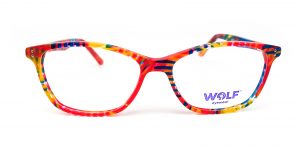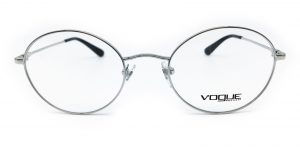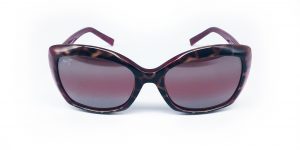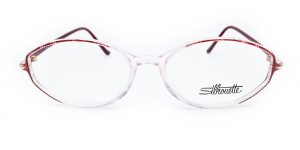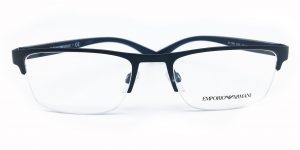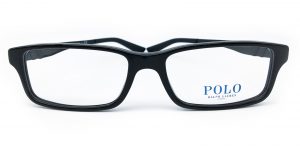Taking Inspiration from Star Specs
Large frames, small frames, brilliantly bold designs – there is a pair of glasses out there to suit everyone.
And as many famous people have found, if you choose the right pair they can become recognisable in their own right.
Taking inspiration from people in the public eye can be a great way to help you choose your next pair of glasses.
So, we’ve searched our stock to find a selection of specs that we think would suit some famous glasses wearers.
Elton John
Known for his statement specs, we reckon that Elton John could really rock this brighter than bright pair of frames from Wolf. These glasses conjure up images of cocktails on a palm fringed beach and would fit perfectly with Elton’s star-studded lifestyle.
John Lennon
They may not be rose tinted but these round metal-framed glasses from Vogue certainly make us think of John Lennon, many of our ranges feature similar styles inspired by his classic eyewear. The shaping of this pair particularly suits people with a softly curving face.
Audrey Hepburn
No one carried off a pair of large-lensed sunglasses like the legendary Audrey Hepburn. We really love these tortoiseshell framed sunglasses from Maui Jim, and we are pretty sure Ms Hepburn would have too. Picture them worn with a wide brimmed sun hat and chunky earrings and you would certainly be heading towards the Breakfast at Tiffany’s vibe.
The Queen
For stately style we humbly suggest the Queen would approve of these frames from Silhouette. The monarch errs towards frames which are barely there with oval shaping. This pair accentuate the eyes beautifully without being showy and would be perfect worn at any occasion – from daily outings to Royal garden parties!
Harry Hill
Think of madcap comic Harry Hill and we bet his glasses are one of the first things that come to mind. Dark half frames fit perfectly with his fast-paced creative personality. This pair from Emporio Armani are a good match for Harry’s famous specs and would be great for anyone looking to accentuate the upper part of their face.
Louis Theroux
King of geek chic, documentary maker Louis Theroux wears heavy dark frames bringing focus to his expressions and his curiosity. We think this super stylish pair of Polo frames would definitely be on Louis’ wish list.
Did you know you can browse our extensive range of frames online? Once you have selected the pair – or pairs – you like, with just the click of a button we can have them ready for you to try on when you come in for your appointment.
And if you are thinking about choosing some new frames, take a look at our blog which offers advice on picking the right pair for your face shape.
Back to news articles
Using technology to better examine your eye health
For years the standard way of checking the health of the back of your eyes has been either direct ophthalmoscopy (when we get really close with the bright light) or slit-lamp ophthalmoscopy where you have your chin on a chin-rest and we look inside the eyes using a microscope, a bright light and a super-powerful magnifying lens.
All optometrists are highly skilled at recognising anything that may be wrong, the only problem with this is one of comparison. Judging whether the appearance of someone’s retina two or more years ago has changed or not, can be difficult, even when comprehensive notes are kept. That’s where photographs can be invaluable.
Many eye conditions can be particularly hard to detect because the changes in the appearance of the back of the eye can be very subtle and slow. If we take glaucoma as an example, the appearance of what’s called the optic disc, where the optic nerve joins the back of the eye, is one of the things that we monitor very closely. Glaucoma damages the optic disc and it’s shape and size change slowly as the damage occurs over time. If we have images to compare, then this damage can be picked up a lot earlier than would otherwise be the case. This is not just true of glaucoma, the detection of diabetes and other problems hugely benefit from this too. At Patrick and Menzies, we were early adopters of this technology, known as Fundus Photography over 15 years ago.
Since fundus photography became commonplace, a newer, more advanced technology became available, known as Optical Coherence Tomography or OCT. From the patient’s perspective the procedure is very similar to fundus photography. However instead of a flat 2D photograph of the retina, OCT uses scanning light beams to create a 3D image, not unlike an ultrasound, of the retina. The advantage of this is that we can see the deeper layers of the retina, nerve fibres and blood vessels underneath, things that can’t be seen on a conventional fundus photograph. Conditions like Glaucoma, diabetes and many others can be picked even earlier than before, enabling treatment before any significant sight loss or other complications can occur. We installed OCT in all our practices over 5 years ago and they have proved invaluable.
Our Braintree practice also has something called Optomap. These machines give us an ultra-widefield image of the back of the eye, enabling easier detection of any problems in the peripheral areas of the retina.
These more advanced ways of examining your eyes are a standard part of our private eye examination, and included if you are part of our VisionPlan scheme.
For anyone who receives a basic NHS check, they are available as an upgrade for a small fee.
For more information, or to book an appointment, just get in touch. We’d be very happy to look after you!
Back to news articles
Brand Spotlight | Flexon
In 1961 US Naval scientists discovered that the metal alloy they were creating for missile heat shields automatically returned to its original shape, even after being hit with a hammer! This advanced memory material became the unique selling point of Flexon, which, since its launch in the US in 1988, has changed the world of eyewear with its unique attributes, building on the memory metal and further utilizing Japanese materials and technology.
Many brands have tried to imitate Flexon’s incredible success, but none have done so. That’s because Flexon frames feature technologically advanced memory metal in the bridge and/or temples allowing them to be flexed, bent or twisted and yet return to their original shape. Flexon frames require a minimal amount of adjustment but the nose pads and end pieces can be fine-tuned for a more custom fit.
Over the years Flexon eyewear has consolidated its design and manufacturing experience to create a varied collection filled with colour and comfort. Memory metal is combined with rubber, TR90 and stainless steel to make lightweight yet durable frames which allow the user to confidently go into any situation their busy lifestyle demands.
In 1997 Flexon Juniors launched: We all know how hard children can be on their glasses, so the Zeus and Aphrodite frames, among others, offer mature yet fun looks in durable, sit-on-able, chuck-in-your-school-bag-able memory metal.
in 2003 the Flexon 600 series quickly became the industry benchmark and in 2014, the modern, practical Evolution collection debuted. From these ranges, the temple of the Nathaniel model has been enhanced with an embossed, rectangular-brick pattern in contrasting shiny and matte finishes; the Julian has bowed temples to accommodate a wide fit; the Gloria is enhanced with a laser etched pattern design with crystal detailing and the best-selling Mariene has two-tone interwoven stainless steel temples.
In 2016 the Sun Collection launched in a rage of classic styles with polarized lenses and backside anti-reflective coatings, and in 2019 the new premium collection, Flexon Black: Sunglasses come in classic aviator and flat metal shapes and Flexon Black offers innovation with screwless spring hinges and tailored temples padded with rubberized detailing.
Flexon spectacles are an ideal choice if you play sport in your glasses or just tend to put your glasses through a lot, but a word of caution: Although Flexon frames are durable, they are not indestructible! Flexon frames should not be twisted more than 90° and Flexon temples should not be twisted more than once around the finger!
Having said that, it’s a stylish, lightweight range well worth considering, so pop in to any of our branches when you’re next in town to see which models we have in stock and how amazing the memory metal really is!
Back to news articles
Glasses, Goggles and Contact Lenses for Sports
If you play a lot of sport then your regular glasses may be driving you a bit mad – misting up when you get sweaty, shifting when you swing the golf club or getting knocked off in a tackle. You may feel you need to take them off if playing a racquet or more intense contact sport like rugby where an impact could mean serious eye injury. In fact, if you’re a sportsman or woman then wearing your glasses may well be affecting your performance. So, what can be done?
Get Special Glasses or Goggles…
Lenses in sports eye wear are usually made of polycarbonate as it’s an impact-resistant lens material that works well to protect eyes from fast-moving objects. Polycarbonate also has built-in ultraviolet protection – especially important for golfers, cyclists, cricketers and runners who may spend many hours in the sunshine. Untreated polycarbonate lenses can scratch easily, though and so most will include a scratch-resistant coating on both the front and back surface to keep them in shape for longer.
Sport frames are usually constructed of highly impact-resistant plastic and most come with rubber padding to cushion the frame around the temples and on the nose, but sports glasses and goggles are made in a variety of shapes and sizes. There are different designs for different sports and some are even designed to fit inside the helmets necessary for cycling or American football, for example.
Sports protective styles of frames are often contoured, wrapping slightly around the face. They also sometimes come with an elastic restraining strap that hugs the back of the head to keep them firmly in place and they often come in rimless styles or with vents to avoid misting.
If you’re a shooter or sailor, the choice of lens tint may be your ultimate priority and styles popular with those who practice these sports even boast interchangeable lenses to ensure 20/20 visibility in all conditions.
Swimming and ski goggles can be made with lenses that correct your spherical powers (sphere only) or your full prescription, just like a regular pair of glasses. Ski hybrids can come with foam surrounds or side shields to protect from the cold.
The possibilities really are endless, so come and discuss your specific requirements with us.
…Or Switch to Contact Lenses?
Often the most appropriate way of correcting the vision for sport is with contact lenses and we have lenses for every sporting lifestyle: Whether your concern is that you spend a lot of time in the sun and want lenses with UV protection to make sure your eyes are protected, or you’re just tired of glasses which fall off, mist up or impede your peripheral vision at crucial moments, we will find the contact lenses to suit. And that includes those who have varifocal prescriptions or indeed astigmatism.
So even if you have been told you’re not able to wear lenses in the past come and have a chat – chances are we can help. (And for less than you may think!)
Back to news articles
Lens Treatments | Options and Benefits
When you buy a new pair of glasses it’s not just the frames that come in a myriad of options – these days your lenses can be ‘upgraded’ with various tints, coatings and treatments. But there are so many it can all be a bit confusing – let us break down the most common options and the benefits they bring:
Anti-Reflective
Anti-reflective coating (also called AR or anti-glare) is perhaps the most commonly offered lens treatment, and with good reason: AR coatings not only benefit vision and reduce eye strain, but they can also improve your communication skills! That’s because they make the lenses in your glasses look nearly invisible, so people can see your eyes and expressions more clearly, and you can make better eye contact with them.
An AR coating virtually eliminates reflections from the front and back surfaces of your lenses, meaning more light passes through, allowing your eye to receive a higher percentage of the actual light available – up to 99.5 percent. This means less glare, sharper vision and greater comfort. AR coatings are also a good idea for sunglasses, because they eliminate glare from sunlight reflecting into your eyes from the back surface of tinted lenses when the sun is behind you.
As an additional benefit, most anti-reflective treatments have a special layer that prevents spots and makes them easier to clean, although any scratches do tend to be more obvious on AR coated lenses, so be sure to only use products and cleaning methods we would recommend!
Photochromic
Photochromic lenses automatically darken in bright sunlight (triggered by ultraviolet radiation) to make your eyes more comfortable. Because UV rays penetrate clouds, photochromic lenses may darken on grey days as well as when it’s sunny and they will not darken inside a vehicle because the windscreen glass blocks most UV rays. However, some newer types of photochromic lens activate with both UV and visible light.
An added benefit of photochromic lenses is that they shield your eyes from 100 percent of the sun’s harmful UVA and UVB rays and because exposure to sunlight and UV radiation has been associated with cataracts later in life, it’s a good idea to consider photochromic lenses for children’s eye wear as well as for the spectacles of outdoor-loving adults.
Polarized
Polarized lenses are anti-glare and virtually eliminate bright light from reflective surfaces and so are especially popular with fishermen and sailors.
Scratch-Resistant
Untreated lenses are surprisingly fragile, and it’s very easy to scratch them by storing them incorrectly, placing them down hastily or even cleaning them with some kitchen roll rather than the proper cloth! Luckily, lenses that are treated front and back with a clear, scratch-resistant coating have a much harder surface that is more resistant to scratching and more durable. It’s worth asking about this, because scratches are not only unsightly but can also seriously compromise the clarity of your vision. Nowadays some lenses have a built-in scratch-resistant coating, but double check that this is the case with your prescription.
Lots of options, then! Pop in a have a chat with us to choose that which best suits your lifestyle.
Back to news articles
Brand Spotlight | Lulu Guinness Frames
Dare to be different! That’s the motto of Lulu Guinness, who is perhaps most famous for her statement handbags, much loved by trendsetters such as Kate Moss, Emma Watson and Paloma Faith.
Remember the red lips clutch bag that was much imitated a few years ago? That was Lulu Guinness and she makes a knowing little nod to that iconic image with her signature little red lips printed on the arms of each of the frames in her eye wear collection.
Lulu Guinness at Patrick & Menzies
We love the Lulu Guinness range here at Patrick & Menzies because they are definitely a talking point, but without being over-the-top wacky! Rather, they are sophisticated, with a touch of daring – featuring inter-plays of colour and dramatic retro shapes.
The collection is targeted “at women with a fierce sense of humour and an even fiercer sense of their own femininity” and we can see these frames being snapped up by our clients that are looking for something playful and modern, but with a touch of gravitas.
Style details are important to this designer and along with the red lips and metal logo inlay, these frames come in a veritable rainbow of colours, and patterns including animal print, glitter, polka dot, and the trademark black, white, and red – whether you’re looking for a striking silhouette, vintage glamour or subtle whimsy, there’s a frame in this collection to suit.
High Quality Frames
But style doesn’t come at the expense of substance – Lulu Guinness frames are made from high-quality materials, built for the rigours of everyday wear and some of the styles are offered in an alternative, more generous fit. They are super comfortable too, with adjustable or integrated ergonomic nose pad systems and cushioned hinge bracket arms.
“Glasses have become an expression of one’s individuality”, Lulu says. “I wanted my frames to be beautiful objects in themselves as well as flattering for the face”. And they certainly are – luxurious yet affordable, the Lulu Guinness range is in all our stores and, as you would expect, we can fit them with the highest quality lenses that are right for you.
Pop in and browse the collection. We look forward to seeing you!
Back to news articles
Finding the Right Frames for Your Face
While it’s wonderful that we have so much choice these days in terms of frames it does make the process of choosing the right pair for you somewhat more complicated!
If you’re finding it hard to narrow down the choices, then a good place to start is thinking about your face shape. Generally speaking, people tend to fall into one of five categories: Round, heart shaped, oblong, square and oval:
Round – a softly curving face that is as wide at the forehead as it is at the jaw and with wide cheekbones.
Heart-shaped – sometimes called an inverted triangle. Wider at the forehead and gently tapering to a more pointed chin.
Oblong – sometimes called narrow. A face that is longer than it is wide.
Square – a broad forehead and squarish jaw line.
Oval – a well-balanced face with defined cheekbones and no one dominant feature.
Most people have probably never thought about which shape their face most closely aligns to, and it may be that what you instinctively think you are isn’t quite true. Rather than relying on a friend cocking their head to one side and looking at you quizzically, it’s often easiest to look in the mirror and use a lipstick or a water-based felt tip pen to draw around your reflection (please don’t pick up a permanent marker by mistake!).
Once you’ve established which shape you most align to then see if these suggestions help you find a frame that suits your contours!
Frames for a Round Face
You may find rounder, smaller frames (think John Lennon) just make your face rounder still, so try out square and rectangular frames with strong angles for balance. Ray-Ban Wayfarer or Clubmaster-type styles (think James Dean and JFK) can also work well, if you prefer a quirkier look.
Frames for a Heart Shaped Face
Heart-shaped – over-sized, pilot-styles and half-rimmed frames don’t work on this type of face as well as oval shapes do, but rimless glasses in particular will also work incredibly well for you. (Think Kate Beckinsale and Richard Gere)
Frames for an Oblong Face
Now, pilot styles do work for those with narrower faces (Brad Pitt and Tom Cruise are particularly fond of these!) as well as square, angular frames. Steer clear of narrow frames as they can make your face appear longer.
Frames for a Square Face
Continuing on the opposites attract route, square faces should opt for round and oval frames that soften the angles of the features. (Think Kendall Jenner and Justin Bieber) Or go for browline frames for a vintage look. Anything too strong or geometric won’t work as well for you.
Frames for an Oval Face
We should be so lucky! Anything goes for ovals so just enjoy having the freedom to explore the entire range Patrick & Menzies has to offer and pick whatever makes your heart sing!
Whatever your face shape, pop into any of our branches to start your selection!
Back to news articles
Brand Spotlight | Tiffany Frames
Perhaps the world’s most loved and recognisable jeweller, Tiffany & Co. launched its own brand of frames, exclusively designed for women, and its one of our most popular ranges.
History
In the 1830s Charles Lewis Tiffany and John Young had a dream of opening a jewellery store that everyone knew and admired. From small beginnings as a ‘stationery and fancy goods store’ the company became popular with fashionable ladies and first won international recognition at the 1867 Paris World Fair. Tiffany’s introduced the engagement ring as we know it in 1878 and in the same year produced the first catalogue, with a cover in the iconic Tiffany Blue. The brand we all know today has over 200 stores worldwide, known still for its exquisite jewellery and dazzling accessories. Kate Winslet, Anne Hathaway, Natalie Portman and Lady Gaga are just some of the celebrities who are often seen wearing Tiffany jewellery.
“As a luxury fashion accessory, eyewear seems like a natural addition for us” said Michael J. Kowalski, the Chairman and CEO of Tiffany’s, upon the launch of their optical collection: As you may expect from a jeweller, many of the styles are adorned with gemstone embellishments. As you would certainly expect from Tiffany, their signature blue also features heavily!
Style
The frames are romantic and glamorous – dainty charm symbols such as the lock, key and heart appear frequently and the materials used to decorate the frames include gold, silver, diamonds and other precious gems. There are styles with delicate knotworks in silver running along the arms, little clusters of gems which catch the light, or chunkier styles with a tiny Tiffany & Co. plaque! The frames themselves are mainly made from acetate, which is strong, flexible and hypoallergenic.
With a legacy spanning over 160 years, Tiffany glasses are timeless but never old-fashioned. The bold colours and thoughtful details mark these frames out as something quite special and there’s lots of unusual shapes and colours you won’t find anywhere else – from cats’ eyes to rectangular; from an elegant smoky grey to a feminine and flattering blush pink.
Pop in and browse this most luxurious of collections. We feel sure you’ll be as impressed as we are with the detailing, and of course, any of them can be fitted with exactly the right lens for your needs. We look forward to seeing you.
Back to news articles
Prescriptions | What does all that information mean?
For many of us, an eye examination is more about the immediate concern of whether your current prescription has changed or, indeed, whether you actually need glasses to help you see better, than anything else!
At the end of your appointment your optometrist will issue you with your prescription: A piece of paper with a series of numbers on it that tell us the sort of lens you need to correct your eyesight. It’s rather grandly known as your ‘refractive error’. The perfect eye projects a sharp, clear image onto the retina, known as ‘emmetropic’. If your eyes don’t do this (and most don’t) it’s most commonly because they have a refractive error and that means the image you see is blurry.
You may have heard the terms ‘short-sighted’, ‘long-sighted’, ‘astigmatism’ or maybe even ‘prisms’, but do you really know what they mean?
What’s a ‘Normal’ Eye?
The power of your lens is measured in units called ‘dioptres’ and most prescriptions are relatively low in power – for comparison, the NHS considers a complex prescription to be anything over 10 dioptres.
A ‘standard’ eyeball has a focusing power of +60 dioptres. This brings light rays coming from a distance to focus on the retina at the back of the eye which is considered to be 22.22mm in length. Around +45 dioptres is provided by the cornea (the front, curved, clear part of the eye) and around +15 by the lens inside the eye. Problems occur with this system if any of these numbers differ from the norm.
Short-sightedness
Let’s start with the most common problem: Short-sightedness. Short-sightedness is correctly known as myopia, which means you can only see objects close to you: The closer you have to be, the more short-sighted you are. If you have myopia then objects at a distance create a blurry image on the back of the eye. This happens because the parts of the eye that bend the light rays are too strong or the eyeball is too long. When you get closer to the object, the light rays arriving at the eye start to diverge, which counteracts the ‘over convergence’ of the light rays and pushes the focus back onto the retina.
Someone who has a myopic prescription will have a minus figure at the start of their prescription, meaning the lenses in their specs (or contact lenses) are diverging: This counters the eye which is effectively over-plussed.
Long-sightedness
Now let’s get onto the more difficult one! Long-sightedness! Hyperopia (sometimes called Hypermetropia) is more difficult to explain. If short-sightedness means you can see things up close, then being long-sighted means you can see things far away, right? Well, not really… although sometimes, yes, that is true! Bear with us!
In this case those light rays coming from a distant object are focused behind the retina. This happens because the parts of the eye that bend the light are not strong enough and the eye effectively doesn’t have enough power to bring the rays to the correct point on the retina.
Some people with a relatively low amount of long-sightedness can see objects clearer if they are really far away – for example, we hear of sailors saying they can see a buoy on the horizon, but they struggle to see the TV, or an HGV driver who can see motorway signs in the distance but not the train times on the monitors at the station.
Someone who is long-sighted will have a plus figure at the start of their prescription, their lenses are plus powered (converging). This compensates for the fact that the eyeball is too short.
Astigmatism
Ok, now let’s get into the tricky diagnosis: Astigmatism. If you have an astigmatism then your eyes don’t produce a single point focus, but actually produce two ‘line foci’. Effectively the eye has two different powers at 90 degrees to each other. This is caused most commonly by the cornea having two different curvatures. In an astigmatic eye the curvature of the cornea will vary: It will have two different curves, one steeper than the other, at 90 degrees to each other.
These curves mean that the eye may be more shortsighted in one meridian than the other, or more longsighted in one, or even long sighted in one and shortsighted in the other, which, as you can imagine, requires a more complex prescription.
Prism
Our eyes produce two images and send these back to your brain. These images are also upside down just to make things more complicated! So how do we see one of everything, the right way up?
Well, that relies on the precise co-ordination of both eyes and the fact that they both line up and point at the same object at the same time. The eyes do in fact produce two very slightly different images and that is how we perceive depth properly, but the difference between them is only slight. The images have to fall in corresponding areas on the right and left retinas for you to only see one of the object you are looking at. If the images fall partly or wholly outside these areas, the brain cannot match them up properly and they become blurred, or even double. The direction of gaze and how well controlled it is, is governed by six muscles around each eye which move left, right, up, down and obliquely. If you have a problem with one or more of those muscles, then it can mean that the images produced become too different from one another.
As the brain senses this mismatch it will tell the muscles to work harder to overcome the problem, sometimes they can but often this will lead to eyes feeling tired (it’s hard work!) or achy. Sometimes this can cause headaches too.
If we detect this issue in an eye examination, then in some circumstances we’ll prescribe prism. This allows the eyes to take up their comfortable position, thus removing the symptoms; and shifts the images on the retina, lining them up so the eyes don’t have to work so hard. In the vast majority of cases you wouldn’t know someone with prism has this correction as the deviation of their eyes is so small it’s not cosmetically noticeable.
You don’t need to worry too much about what your prescription says – that’s our job. But you do need to make sure you’re having regular check-ups to keep the information correct. Pop in and see us at any of our branches for an appointment so we can keep your sight crystal clear.
Back to news articles
A Short History of Contact Lenses
Isn’t it something of an everyday miracle – pop a tiny little lens in your eye and suddenly, 20-20 vision! For many of us, contact lenses are a lifesaver, but did you ever think how they might have come about?
In 1508 Leonardo da Vinci recorded the idea that the optics of the human eye could be altered by submerging the cornea in a bowl of water in his work Codex of the Eye. Later, in 1636, after reviewing Leonardo’s work, the French scientist Descartes wrote an essay in which he discussed placing a glass tube filled with liquid in direct contact with the cornea to improve eyesight. These ideas, while visionary (do you see what I did there?) were sadly impractical and no significant advances were made for almost two hundred years.
In 1801 Thomas Young made ground-breaking advances in describing astigmatism, and also, the very bold move of gluing water-filled glass tubes to his eyes with wax, building on Descartes’ work. Unsurprisingly this didn’t catch on and it wasn’t until 1845 that another British scientist, John Herschel came up with the idea of casting a mould of an individual cornea and making corrective lenses for that eye. No-one could quite come up with a way of doing that until over 50 years later, when within a year of each other a German false-eye manufacturer called Mueller and a Swiss physician called Flick both made prototypes of glass lenses which fitted over the entire white of the eye. While huge steps forward, these lenses were heavy, uncomfortable and essentially ‘suffocated’ the eye of oxygen so could be tolerated for a few hours at most.
The Americans took over in the 1900s with Feinbloom combining the glass lenses that sat on the cornea with a plastic surround which was more permeable and therefore more comfortable. (This was possible because of advances made by the Hungarian Dr Dallos who had worked on Herschel’s theory of mould-casting and perfected a method of doing so.) Later Kevin Touhy, in a happy accident, broke off the plastic surround of his lens and discovered that his vision was still corrected by using only the part that sat on his cornea. This meant the white of the eye could be left to breathe and so lenses could be tolerated for longer.
After this breakthrough the advances in lens technology came thick and fast: Leonardo’s insistence on the importance of water was borne out by the invention of the hydrogel lens: In 1958 Czech chemist Wichterle, together with his colleague Lim, created the first ‘soft’ lenses that were permeable, pliable and much thinner than glass lenses.
By the 1970s and 80s lenses were becoming more comfortable and could be worn for much longer periods. Today of course we have disposable lenses and even lenses that can be worn overnight or for weeks at a time, with better oxygen permeability and water content, making them a safe, comfortable and convenient option for many people.
Why not come and have a chat with one of our knowledgeable team to find out which type of contact lens may be best for you!
Back to news articles

